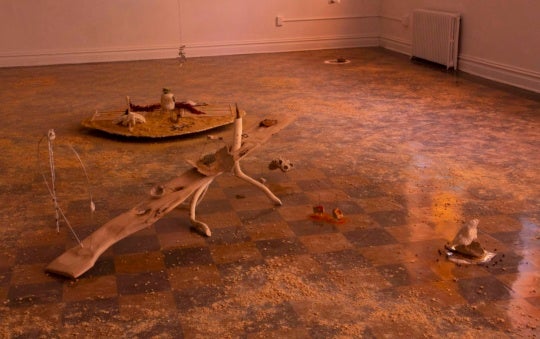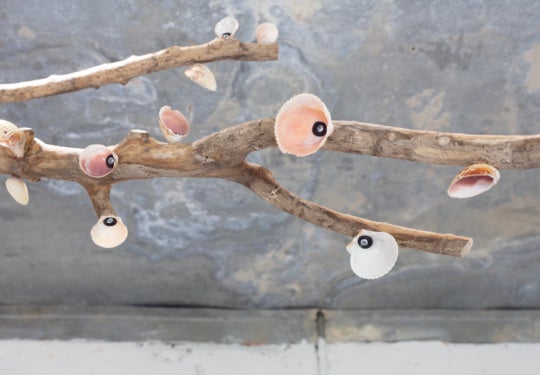
The exhibition “The Future is Female” is not an exhibition strictly about being female. Instead, the exhibition and its title—a resurrected 1970s T-shirt slogan with an interesting history—is a call to arms for women and a declaration to everyone about the power, breadth, and resilience of the female perspective. Organized in honor of the tenth anniversary of 21c Museum Hotel in Louisville for a series called Global Gathering, the show is about universal subjects like nature, economy, sexuality, mortality, humor, history, and identity—human experiences presented through the female artists’ perspectives.

The legacy of feminist art of the 1970s provides the historical context for many of the nineteen women in the exhibition. Chief curator Alice Stites deftly incorporates currents of that movement throughout the exhibition without implying the works are merely derivative. For example, Stites points out in her useful exhibition essay the prevalence of language as a feminist tactic to disrupt power. In the exhibition, Carrie Mae Weems’s Untitled work from the Hampton Project series (2000) and the photograph of Holzer’s Berlin projection I am afraid (2006) employ language to question structures of authority. Holzer’s contemporary work provides a critical feminist rooting that connects her present work to the past, while echoing her counterparts in the movement like the Guerrilla Girls and Barbara Kruger.

In addition to language as a core feminist tool, the reclaiming of traditional craft methods and decorative materials is another thread that connects the past to the present in order to critique contemporary social issues. Commenting upon wealth and consumerism, South African artist Frances Goodman incorporates beads and embroidery in her work Codo de Oro (Elbow of Gold) (2006), a Spanish phrase meant to call out a contradictory stinginess despite its lavish gold beadwork on silk. The implication is that one who is cloaked in gold is physically unable to pay.

One of the most enigmatic pieces in the exhibition is Goodman’s Medusa (2013-14), a serpentine, writhing protrusion of tentacles projecting from the wall with snake-like patterns and shimmering scales. These scales are made from acrylic press-on nails, a superficial ornament of female seduction. Medusa is a fraught symbol; she is the source of beauty in mythology, but also demonized to critique women of power. Medusa‘s seductive tentacles are at once powerful because they are beautiful and alluring, and powerless because they are disembodied and hung like a hunting trophy covered in artificial materials. Goodman’s Medusa is the most subtly suggestive and complex piece in the exhibition, and it fittingly holds a prominent place in the installation.

Not surprisingly, sexuality, identity, and body politics are prevalent themes. However, the selection of works that address these common topics is nuanced to present shifting viewpoints from how women see themselves—both privately and publicly—to how they see one another, and finally to how they are objectified by society at large. Nina Katchadourian’s two-channel video Under Pressure (2014) from the Seat Assignment Project features the artist in makeshift costumes singing in an airplane bathroom. Watching a woman imagine herself as male icons David Bowie and Freddie Mercury in an intimate space feels voyeuristic. In contrast, Kathleen McQuade Olliges addresses the external demands of physical perfection and nurturing that pervades womanhood. A life-size female mannequin—the epitome of an idealized female physique—is covered in nipples, a symbol of the demands of domestic life and motherhood.

Across the nation, exhibitions of female artists have been cropping up—undoubtedly in protest to assaults on women’s rights and representation in the political arena. While a show of this nature could simply reiterate familiar narratives of the female experience, “The Future is Female” is stronger because Stites chose to include works that address an array of significant broader subjects like the environment, religion, race, mortality, and history. It may seem like these works are out of place in a show presumably about the female experience. However, Stites recognizes that it is reductive and stifling to limit the impact of the female voice to those subjects which are inherently “female.”

For example, Vibha Galhotra’s film Manthan (2015), a meditative journey down the polluted Yamuna River in India, may seem idiosyncratic. Stites says the film “invokes a Hindu legend in which the gods churn the ocean to obtain the nectar of immortality” which can heal the polluted river. Galhotra envisions the role of human, god, and environment in futurity. While Galhotra’s film is not directly about the being female, it is incredibly powerful for a woman to imagine a sweeping epic that imbues one of the world’s most polluted rivers with a sense of optimism.

Toxic waters connect Galhotra to Alison Saar’s Hades D.W.P (2016). Saar takes on the historical subject of the Great Mississippi Flood of 1927, the most destructive flood in the history of the United States, which displaced hundreds of thousands of African Americans who then joined the Great Migration. She presents this story in a quasi-domestic (presumably feminine) setting with liquid-filled jars etched with the images of the dead and dying. Ladles hang from the pantry shelf inviting the risky to take a drink of the deadly water, a cross-reference to water contamination in Flint, Michigan. Saar is participating in political dialogues of historical and contemporary significance.

Mortality is heavily present in Gaela Erwin’s drawing of her ailing mother Portrait of my Mother in Her Wedding Dress (2013). The frail figure of Erwin’s mother, rendered in the most exquisite but fragile pastel, reclines in a ghostlike state between life and death, present and past. Erwin’s visage is so similar to her mother’s that her drawing seems to foreshadow her own aging.

The works in Michele Pred’s Reflections series (2015) provide an affirmative punctuation to the exhibition, their aesthetic in many ways a contrast to the other works in the show. The series is composed of slick, bright pink mirrors in the shape of the Venus symbol for woman. On each of the mirrors, there is a single word etched onto its surface, “Feminist,” “Equal,” and “Powerful.” These declarative, one-word statements provide a sense of affirmation and empowerment. As a woman looking into the mirror, these words are mantras reminding me to embrace my powerful feminist self. And we need reminding because the battle is not yet won.
“The Future is Female” is on view at 21c Museum Hotel in Louisville through June 11 and will appear at the Cincinnati 21c in November 2017.
Eileen Yanoviak is a PhD Candidate in Art History at the University of Louisville and Adjunct Faculty at the University of Arkansas at Little Rock. She is also Membership Manager at the Speed Art Museum in Louisville, Kentucky.





